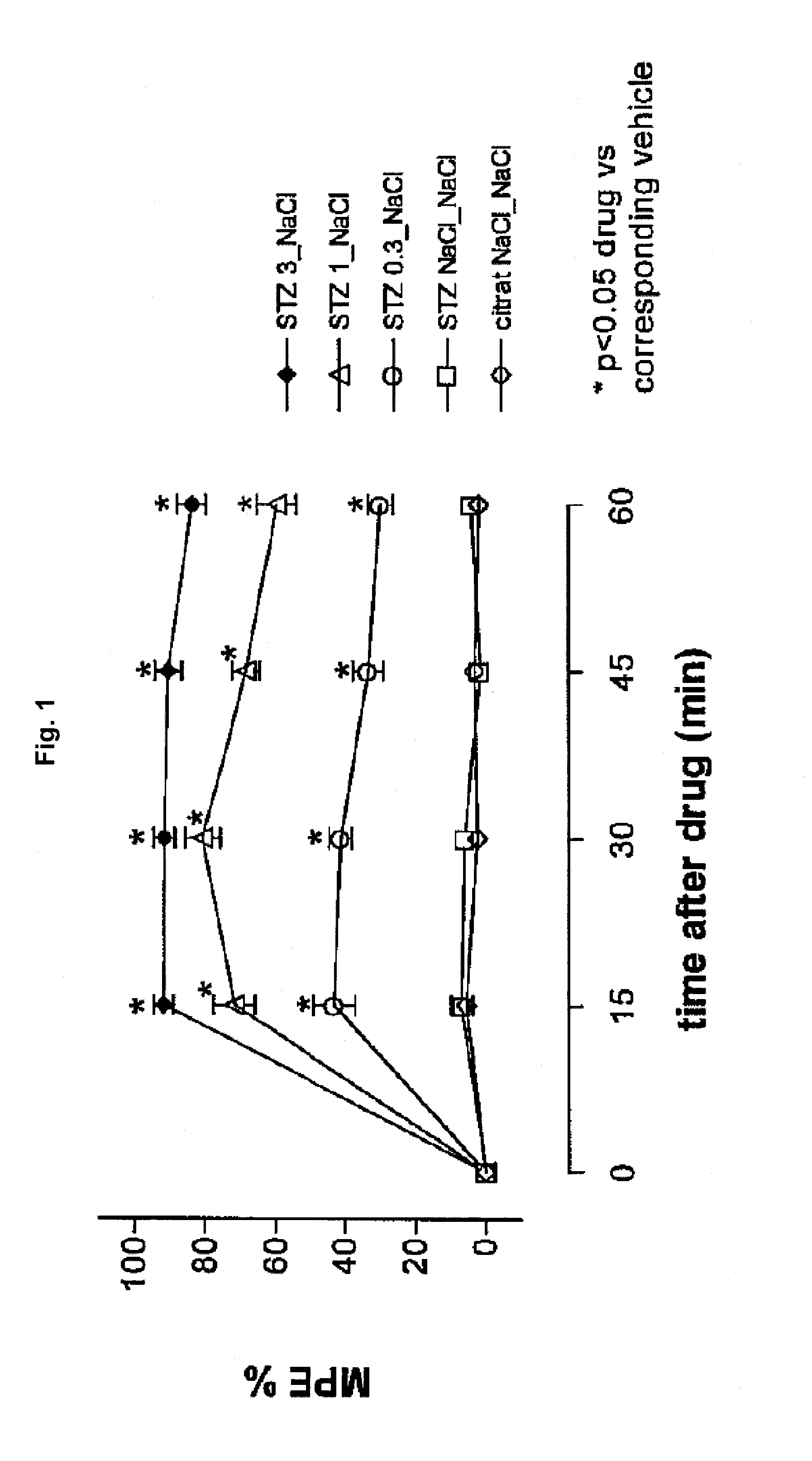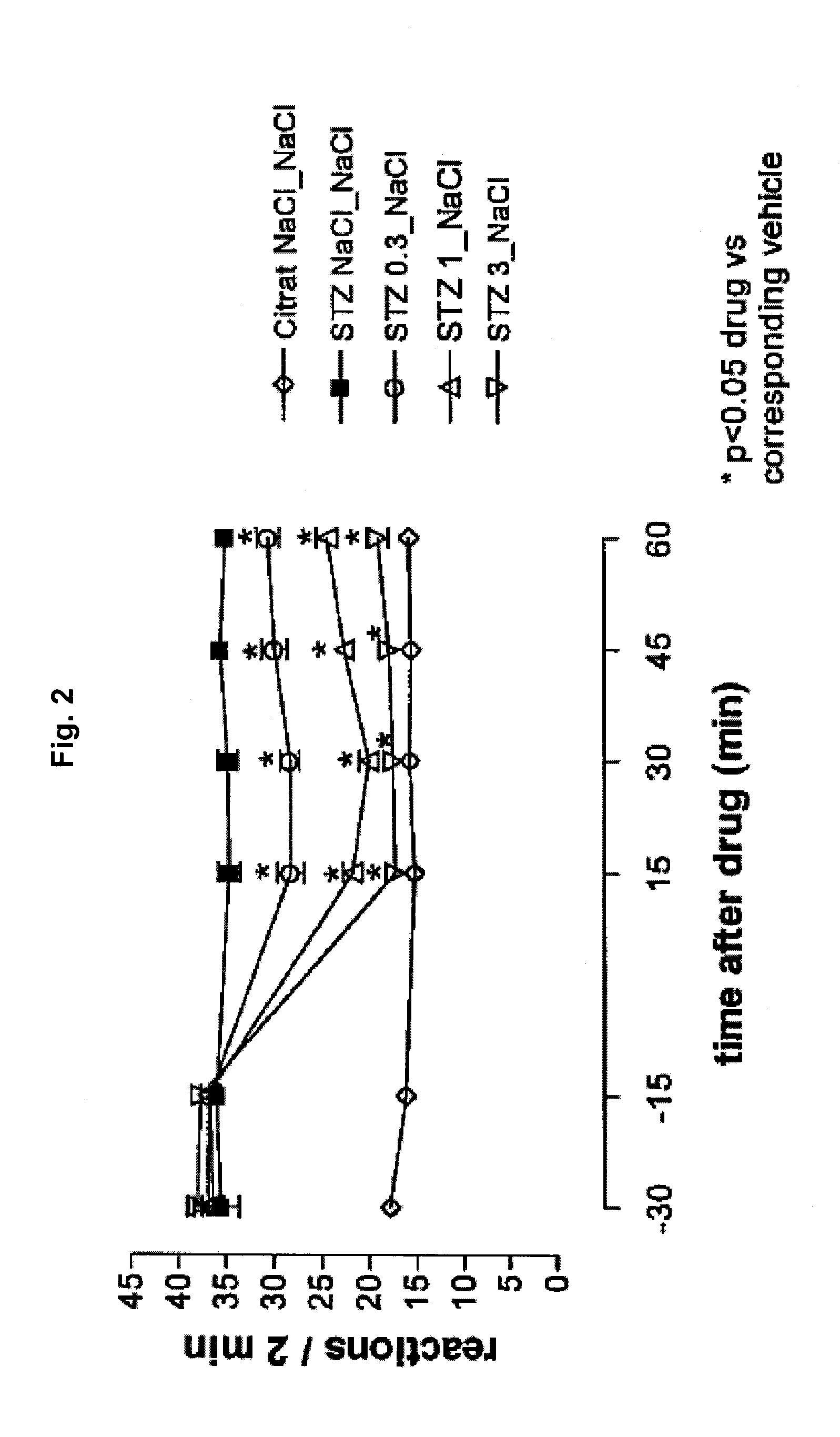Parenteral Administration of Tapentadol
a tapentadol and parenteral technology, applied in the field of tapentadol parenteral administration, can solve problems such as contamination by microorganisms, and achieve the effect of efficiently relieving pain and efficiently relieving pain
- Summary
- Abstract
- Description
- Claims
- Application Information
AI Technical Summary
Benefits of technology
Problems solved by technology
Method used
Image
Examples
example 1
[0192]a) A tapentadol HCl solution was prepared by dissolving 20 g of Tapentadol HCl in 1 L water for injection and adjusting isotonic conditions by addition of sodium chloride. The solution had a pH value of below 5.4. Thus, tapentadol HCl has slightly acidic properties when dissolved in water.
[0193]b) Tapentadol HCl solutions for injection containing 15 mg / mL of the free tapentadol base were formulated according to the following table.
TABLE 1IngredientContent [mg / mL]Tapentadol HCl17.47Sodium citrate dihydrate0.50Sodium chloride5.0Water for injectionsAd 1.003 g (1 mL)
[0194]The formulations were spiked with Staphylococcus aureus (Staph. aureus), Pseudomonas aeruginosa (Ps. aeruginosa), Aspergillus niger (Asp. niger) and Candida albicans and their efficacy of antimicrobial preservation was evaluated according to the test “efficacy of antimicrobial preservation” as recommended by the Ph. Eur. The test acceptance criteria for parenteral preparations according to the Ph. Eur. are given ...
example 2
[0196]The effect of the composition of the invention on polyneuropathical pain was then studied as follows:
[0197]Diabetic hyperalgesia was induced in male C57 / BL / 6 mice by a single intraperitoneal injection of a citrate buffered solution containing streptozotocin (dosage: 200 mg / kg; first injection solution). 1-2 weeks later, 5 μL of a second injection solution containing tapentadol or vehicle was injected intrathecally, 5 μl of a third injection containing vehicle was injected intracerebroventricularly and the mouse was placed on a hot plate maintained at 50° C. and the number of nocifensive reactions (licking / shaking of the hindlimbs, licking of the genitals, jumping) was recorded. The cut off time was set at 2 minutes.
[0198]Thermal hyperalgesia thresholds (withdrawal latency) were measured at short time intervals directly after the injection (after 15, 30, 45 and 60 min). The group size was 10. The antihyperalgesic activity of the tested pharmaceutical composition is expressed as...
example 3
[0201]According to Example 2, but with the variation that the second injection solution was injected intracerebroventricularly and the third injection solution containing vehicle was injected intrathecally, the effect of the inventive composition on polyneuropathical pain was studied using the following injection solutions:
TABLE 4I-2I-4I-5C-1C-21. injection solution: citrate solutionSTZSTZSTZSTZ—containing2. injection solution: dosage of1.000.30.1——tapentadol [μg]3. injection solution: vehicel—————STZ: streptozotocin
[0202]The results concerning the antihyperalgesic activities are depicted in FIG. 3. The absolute numbers of withdrawals are depicted in FIG. 4 for each experiment. It is evident from FIGS. 3 and 4, that tapentadol exhibits dose-dependent inhibition of diabetic heat hyperalgesia. Using the thermal hyperalgesia threshold values after 15 minutes, the ED-50 value was calculated to be 0.18 (0.14-0.22) mg / animal for the intracerebroventricular administration.
PUM
| Property | Measurement | Unit |
|---|---|---|
| concentration | aaaaa | aaaaa |
| concentration | aaaaa | aaaaa |
| concentration | aaaaa | aaaaa |
Abstract
Description
Claims
Application Information
 Login to View More
Login to View More - R&D
- Intellectual Property
- Life Sciences
- Materials
- Tech Scout
- Unparalleled Data Quality
- Higher Quality Content
- 60% Fewer Hallucinations
Browse by: Latest US Patents, China's latest patents, Technical Efficacy Thesaurus, Application Domain, Technology Topic, Popular Technical Reports.
© 2025 PatSnap. All rights reserved.Legal|Privacy policy|Modern Slavery Act Transparency Statement|Sitemap|About US| Contact US: help@patsnap.com



